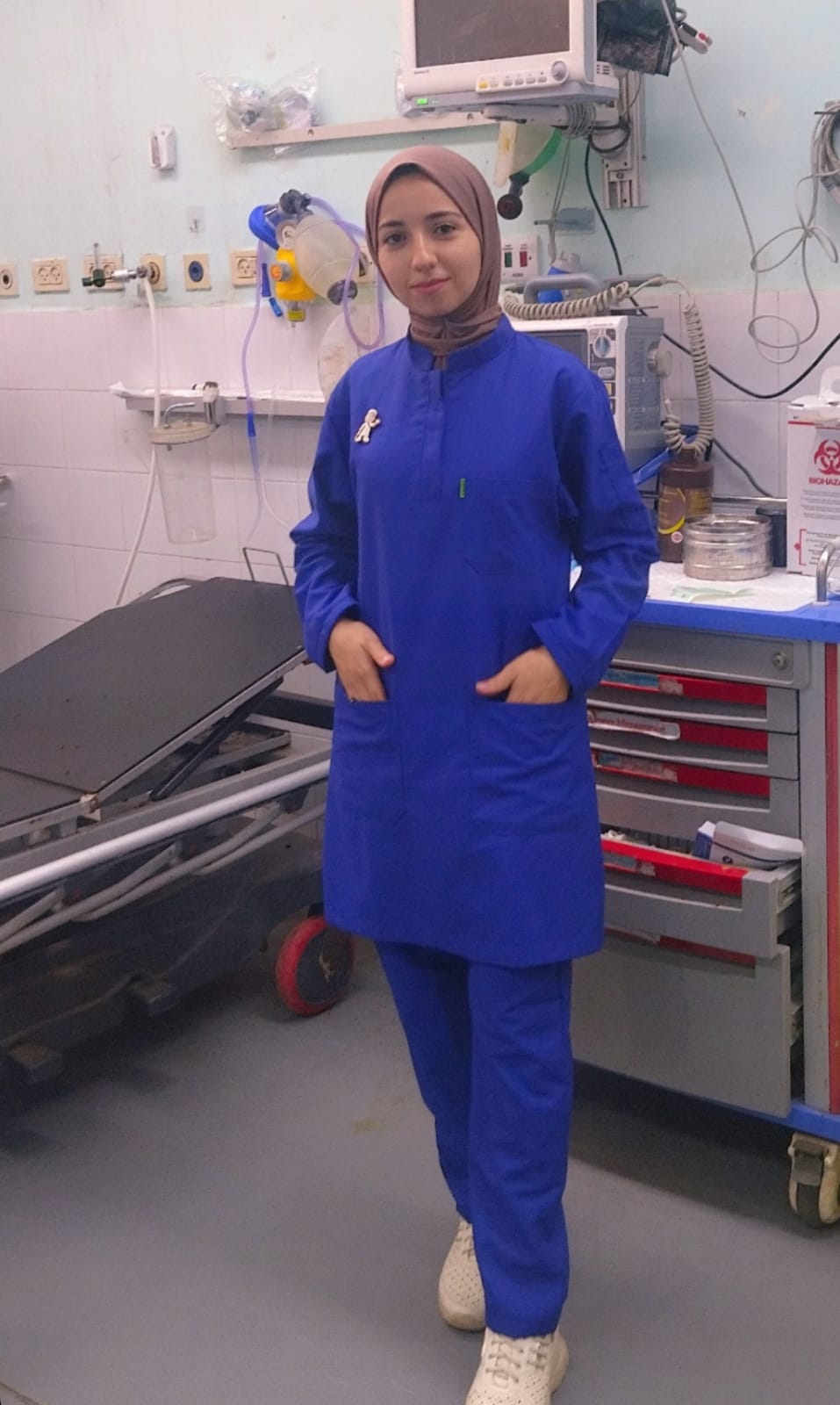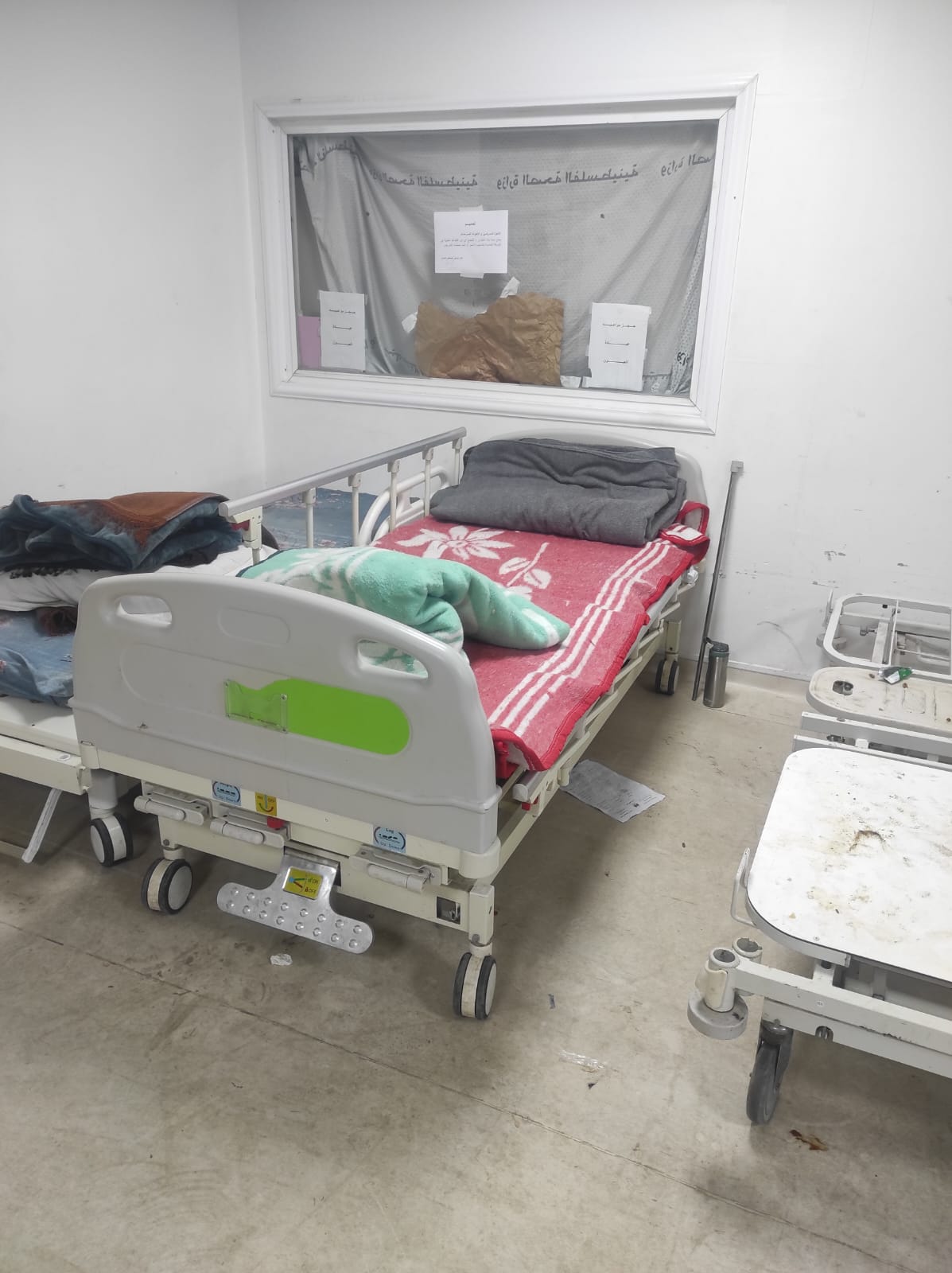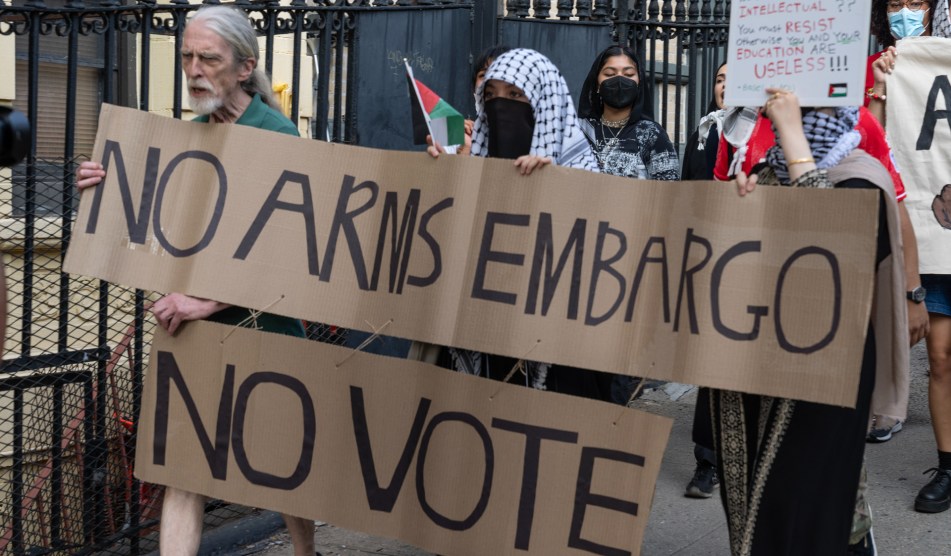On June 6, the Rahma Worldwide international medical delegation arrived at Gaza European Hospital in Khan Younis. The humanitarian volunteers noticed something immediately: Some of the medical staff welcoming them—with the best food available, an assortment of cucumbers, hummus, and french fries—appeared remarkably young to be doctors.
Before the delegation could ask any questions, an airstrike hit the neighborhood. The walls of Gaza European Hospital—then one of the only functioning medical centers in the region—shook.
“Within the first 15 minutes that we were here,” Dr. Mohammed Mustafa, an emergency specialist from Australia, recalled, “nine people came in an ambulance, already dead.”
This, the doctors learned, was typical of the day-to-day life in Gaza. It was only later the international doctors would come to find out that many of the staff were not fully credentialed doctors, but student volunteers. Dr. Bing Li, another member of the Rahma delegation—a team of a dozen doctors from different countries, there to provide support to Gaza’s depleted health system—estimated that half of the people working in European Hospital’s emergency department in June were students or trainees from Gaza’s two medical schools.
“The health care system’s on the verge of collapsing,” Salman Dasti, an anesthesiologist who worked in Gazan hospitals both before and during this war, said. “It’s being propped up because of students.”
“In this war, I lost many of my colleagues and friends from school. I lost four members of my family.”
Mustafa found the students’ ability to keep the hospital functioning remarkable. “We were getting patients moving and getting them treated. It was pretty amazing to see,” he recalled, “especially since you can see how broken they are physically, emotionally.”

On the first day, Li recalled meeting one of the volunteers keeping Gaza’s hospitals running. A patient was brought in and losing blood quickly from a blast injury to his leg. Li worked with a volunteer to stabilize the man; the volunteer then pulled Li aside and introduced herself excitedly in English: Her name was Nermeen Ziyad Abo Mostafa, and she was 20 years old.
“I had this impression she was this very friendly person, and she asked me if I wanted help with translation and seeing other patients,” Li said. The foreign doctor appreciated the aid. Earlier that day, Li, an emergency specialist from Arizona, had already had a heartbreaking experience. “We evaluated one patient that was maybe three or four years old,” she recalled. “Half his head was basically blown off.” (It ended up being “just one of many similar cases,” Li said; other doctors who have returned from Gaza say the Israeli military regularly targets children.)
As Nermeen showed Li around, another doctor noticed who the American was talking to and pulled her aside. Li was told Nermeen had a friend die earlier that same day in the blast that sent a raft of critically injured patients to the hospital.
“She was keeping this brave face despite learning that she lost somebody,” Li remembers.
Nermeen always wanted to be a doctor. As a young child, she said, she “had doctor’s tools in the form of toys.” As she grew older, she watched medical school graduation videos online, transfixed by the celebrations. She imagined herself as a cardiovascular specialist, or perhaps a pediatrician; she was overjoyed when, in 2021, she was finally able to enroll at her dream school: Al-Azhar University-Gaza. (For this article, I interviewed Nermeen using WhatsApp text messages and voice memos. Her internet and data access in Gaza is not good enough for phone calls of length.)
By October 7, 2023, Nermeen had made it through two and a half years of medical school. (In Gaza, students’ medical training starts immediately after high school, when they begin a six-year program of study.) Her tuition was expensive, and the hourlong bus ride to school from her home in Abasan Al-Kabira, a small city east of Khan Younis, made her carsick. But she was happy to be learning.
Then, the war came. In early November, Israeli warplanes destroyed Nermeen’s campus. By mid-January, Israeli bombardment had reduced every university in Gaza to rubble. Nermeen moved constantly. She evacuated from place to place four times in the first six months of the war. Eighty-four percent of Gaza is now under evacuation order. She watched classmates, professors, and friends die nearly every week. “In this war, I lost many of my colleagues and friends from school,” she told me. “I lost four members of my family.”
In April, Nermeen started volunteering at the hospital. It was the “one positive amid all of this,” she said. A third-year student would not ordinarily be actively treating patients. But her clinical phase began early. “I was learning from the doctors and helping them,” she said.
Many of those working and volunteering at the hospital had shifts lasting 24 hours—and no one I spoke with had received payment from the hospital since October. Anything shorter than a 24-hour shift would mean more trips on treacherous roads, made nearly impassable by millions of pounds of debris and sewage overflows from broken sanitation systems.
On a normal day, Nermeen began her shift early in the morning, connecting to the internet and trying to download lectures and readings from the website of her bombed university, before beginning to see the injured, “standing with doctors, talking to patients.”

As a volunteer, she cleaned wounds, translated for foreign doctors, and made treatment plans. “There were days when…the work was a lot, due to the arrival of large numbers of martyrs, and injured,” she said. “But the thing I loved to do most was stitches in the emergency department.”
This was made difficult by short supplies. The sutures in Gaza hospitals were labeled “not for use on humans,” Mohammed Mustafa, the ER doctor from Australia, recalled. Still, he helped Nermeen with her suture technique; he noticed that she was particularly careful in caring for patients during the process. Nermeen did her best to stitch in a way that would minimize scarring.
Conditions were hard. There were no beds, only rigid metal frames. Rooms were cramped and hot. Even the chairs in the hospital were occupied by patients, leaving little room for their caregivers to rest. The complex smelled of rot, and flies landed in patients’ wounds just as Nermeen finished disinfecting them. Even the suture needle was less sharp than it should be.
“It would take you maybe three, four attempts to pierce the skin with the suture,” Mustafa said. “And you can imagine trying to do that with very limited anesthetic, [on] children as well.”
Beyond the shortage of goods, there was also a shortage of personnel. Students did their best to fill in. One 22-year-old student who spoke to Mother Jones, Hasan Ali Abu Ghalyoon, was in his third year of dental school before the war. He was initially told he’d be working as a porter, then a translator. He spent four months volunteering at European Hospital, unable to see his family in Deir al-Balah after the Israeli army took over the area between the hospital and his family’s tent.
“I slept in the office of the International Committee of the Red Cross at the hospital for four months,” he said. ‘There was a broken bed that does not move from its place,” which was not used except for emergencies. When it was unoccupied by patients—and when he wasn’t being called to translate for a surgeon in the middle of the night—he got that bed.
As he spent more time in the hospital, he learned “there was a severe shortage of dentists specializing in maxillofacial surgery,” so he quickly found himself assisting with those surgeries, too. “It is difficult to talk to patients with burns or fractures,” he said, “some of whom lost a loved one with the same injury minutes before.”

Sometimes, the patients the students cared for were people they recognized. On the mid-June day when Nermeen met Bing Li, she wasn’t supposed to be at work. She was at her family’s tent, taking a rest day, when she felt a bomb detonate nearby. “We saw the smoke of the bombing, and a large number of ambulances,” she recalled. Without internet access, Nermeen worried her own relatives might be among the dead.
Nermeen decided to go to the hospital on her day off. “I put on the uniform and walked to the road.” A man with a car offered her a ride when he saw her medical uniform. His family lived in the area that had just been bombed, Nermeen remembered, and he was headed to the hospital, too. Once there, she opened her phone to scroll through the names of the dead. “My friend’s name was among the names of the martyrs of this massacre.” She rushed to the emergency room in hopes that the news was wrong. “But it was true.”
Most of her friend’s family had been killed. She found her friend’s younger sister, Samar, waiting alone, with wounds all over her body. Nermeen monitored her vital signs, stitched up a deep gash in her left foot, and patched up two wounds on her leg.
Samar was later transferred to a different department, where her head wounds were treated. “She remained in care for several days,” Nermeen remembered. Then, Samar was discharged, but “she was still in a state of shock, and would not speak.” At the end of July, Nermeen received word that Samar had been killed, too: “She joined the rest of her family.”
Gaza’s medical system has been painfully constricted for decades. This is partially due to the longstanding Israeli policy of blocking “dual-use items” at the border—medical devices that could, allegedly, be used as weapons. Those items have included crutches, hearing aid batteries, thermometers, and incubators. This means the doctors of Gaza must make do.
Dasti, the anaesthesiologist from San Francisco, visited Gaza multiple times as part of a medical mission group with the Palestinian Children’s Relief Fund before 2023. “I was fairly impressed with the robustness of the health care system,” he said. “I mean, it still lacked resources, but I was pretty impressed with the training that the physicians there had.”
There were 36 fully functioning hospitals in Gaza prior to the war. By mid-August, according to the World Health Organization, only 16 of those 36 hospitals were even partially operational. These 16 hospitals have treated patients far beyond their capacity. Staff is low: The UN Human Rights Office reported that more than 500 medical workers have been killed in Gaza since October 7. And an NBC News investigation recently suggested Israel has targeted doctors for kidnapping and taken them to torture camps. Hanan Balkhy, Eastern Mediterranean regional director for the World Health Organization, said that as of early August, WHO has been able to verify more than 500 attacks on medical personnel in Gaza.
This leaves a staggering hole for those in need of care. The WHO estimates that nearly 93,000 people in Gaza are injured. Among those 16 remaining hospitals, there are fewer than 1,500 hospital beds—about one for every 60 injured people. And those numbers don’t account for those who would ordinarily require hospital beds even in peacetime: diabetic patients requiring dialysis, cancer patients, and pregnant women needing somewhere to give birth.
“The remaining students are now basically frontline doctors, because of just the lack of personnel,” Dasti said. Students spent their days at European Hospital “functioning as essentially an attending physician, while not getting paid and working long arduous hours with little sleep.”
Balkhy, of WHO, said the students are exhibiting “more resilience than anyone should need to have.” Nermeen and her classmates dream of continuing their education—perhaps leaving and studying elsewhere if the borders reopen—but, as Balkhy said, it is “a race against time and circumstance.”
Conditions in Gaza, meanwhile, are only worsening. WHO confirmed the first case of polio in Gaza in 25 years on August 22: “Health workers have been digging graves for patients they know they are not able to save because they don’t have the resources needed.”
Forty-five international doctors who spent time in Gaza published a letter on July 25 addressed to President Joe Biden and Vice President Kamala Harris. Bing Li and Salman Dasti were among the signatories. They detailed the injuries they’d seen—preteens deliberately shot in the head, healthy babies dying of preventable diseases—and noted their “acute awareness” that Gaza’s medical professionals have been targeted. The doctors begged the president for an arms embargo, and for “unfettered aid delivery” of antibiotics, painkillers, and sutures.
On August 1, 300 days into the destruction of Gaza, Nermeen turned 21 in a white tent, as temperatures soared above 90 degrees. As she sent me WhatsApp voice notes, warplanes buzzed overhead and her siblings chattered in the background.
She had been away from the hospital for a month. It was evacuated on July 1. Patients left, or were carried out by hand, over a chaotic 24 hours. “There’s really no roads because they’ve all been destroyed,” Dasti remembered. Taking a patient a couple of miles to the nearest hospital took at least an hour. Even in the United States, under the best of conditions, it is hard to move a patient from the ICU down the hall to the operating room safely. “I think some of them died on the way,” Dasti said.
Hasan, the dental student, evacuated too. He has spent the past two months sharing an 8-by-20-foot tent with four families in Deir al-Balah refugee camp, not far from the site of the Al-Tabin School bombing, in which the Israel Defense Forces used US-made bombs to hit a school building and kill nearly 100 people. He spends time making videos about his work in the hospital, which the international doctors he met have been sharing at conferences back home.
Hasan has been trying to return to European Hospital to see if he could help if it reopens—and perhaps find a path to continuing his studies. (World Health Organization officials told Mother Jones that they are partnering with the Gaza Ministry of Health to restore emergency services at the hospital, though the timeline has been postponed amid heavy bombing.) On WhatsApp, Hasan showed me a map outlining the route he planned to take, with red danger zones highlighted. When he tried to make the journey, “the people on the road told me to go back [because] the army is on the road.” He turned around and returned to Deir al-Balah.
When we messaged last week, Hasan said he had heard a system of buses organized by the International Committee of the Red Cross might be able to bring him back to Khan Younis. But a day after we spoke, Israeli forces once again ordered the evacuation of large portions of Khan Younis—and bombed portions of Deir al-Balah, where Hasan now lives. But he hasn’t given up. “I will try again,” he said.
Nermeen faces similar obstacles. “I am impatiently waiting for the hospital to reopen, because I miss helping and learning new things,” she said. While she heard that administrative work on reopening the hospital began in mid-August, she doesn’t know when it will reopen fully. And returning to the hospital might be dangerous: “Sudden bombing could occur on the road.” So, instead, she has returned to her studies, when the intermittent-at-best internet allows, and when the “terrifying” noises of artillery shells pause long enough to let her focus. One day, Nermeen announced proudly that she’d managed to turn in her endocrinology exam online, to a virtual classroom run by professors from a university that, physically, no longer exists.
“All of this losing makes my heart broken,” Nermeen said. “I hope I can be strong, because my dreams wait [for] me, and many people…I want to help them.”

















